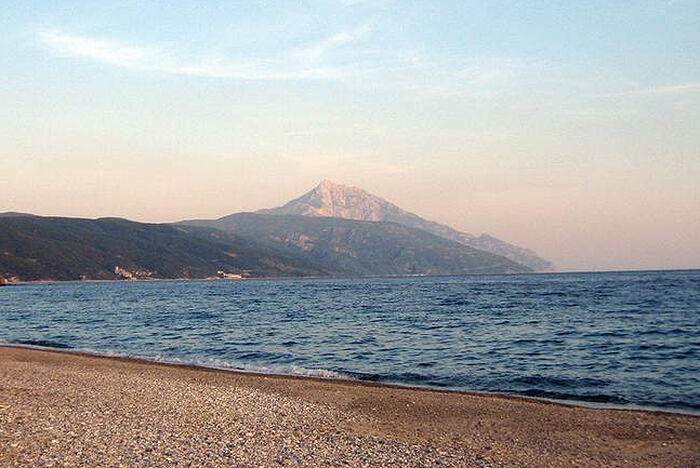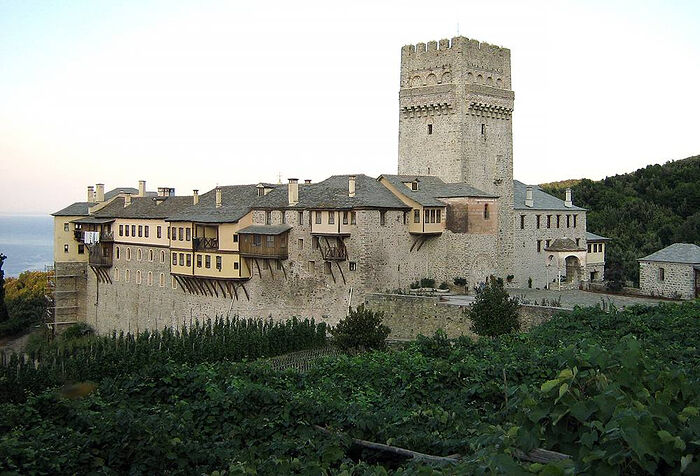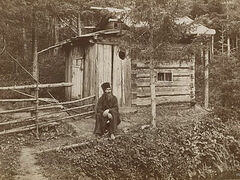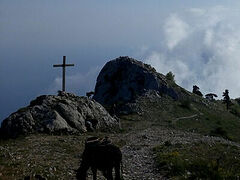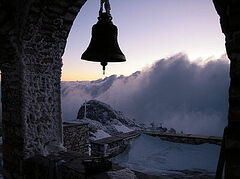Mount Athos is an inexhaustible source of miracles. Their “density per square kilometer” here is so great that, after a short while, you simply stop wondering: “Well, so what, just another miracle!” And you just keep on walking...
The “density” of miracles per square kilometer here is so great that, after a short while, you are no longer surprised at all
But then, at times, you suddenly encounter some miracles among those unique events that will be forever ingrained in your memory and make you ask the same question: “What was it, after all?”
Joy and confusion are exactly what you experience upon an encounter with an undeniable miracle. What earned me this honor when I was visiting Mount Athos I am not really sure even to this day! I will share here only three stories of such miracles, but there were many more there.
Who was I in the eyes of the Church? An Orthodox-crazy, wild-eyed neophyte, definitely past his prime. An unbearably heavy burden of Orthodox resistance to the growing globalization laid heavily, like a disabling burden, on my soul, injuring its delicate and fine “nerve strings”—such as my trust of the priesthood and remaining obedient to the Mother Church. Like so many others at the time, the “Struggle” was at the foreground for me! Thus, imperceptibly, we threw out the baby along with the bath...
But here I was, on the Holy Mountain! I came here to meet with the local elders and to hear words of support in this “Struggle” of mine. But how could it be otherwise, because we are in the right!!! And, hey, it’s so obvious!
That’s what it seemed to me at the time.
Sure, more than sixteen years have passed, but my memory still goes strong. Besides, the short diary entries I was making every evening before bed also came to the rescue. But to tell the truth, they were written provided I still had some strength left after a grueling trek made earlier that day.
The entries are definitive, like short brush strokes on a blank canvas....
“Invisible elders”—temptation or reality?
They may be near you, but you won’t see them!
St. Paisios of the Holy Mountain to his disciple,
Hieromonk Athanasius of the Simonopetra monastery
Everyone knows about the existence of this mysterious monastic group, supposedly living in secrecy somewhere around the Holy Mountain proper, in the south of the peninsula, but... no one has seen them! Such things happen. Rumors of their existence have spread so widely among Orthodox Christians all over the world that not to know about them in our days is almost considered bad form.
Someone pointed out that there are twelve of them and they live as a brotherhood, while others speak of twenty-four elders. Elder Ephraim (†2023), the abbot of the St. Andrew’s skete (not to be confused with the abbot of Vatopedi monastery) quoted for me the words of the Elder Paisios of the Holy Mountain (†1994) and, as they say, “There are fifty elders on Athos, but the Mother of God will not reveal them until the time comes.”
You can also hear sometimes that these elders actually live scattered all over Athos instead of residing somewhere as a close-knit community at the foot of the Mountain. This version fits in with what I had heard from my friend Victor, a former resident of Krasnodar, who resides at the Russian St. Spyridon of Tremithus Kaliva conveniently located in the north of the peninsula, not far from the village of Giannitsa.
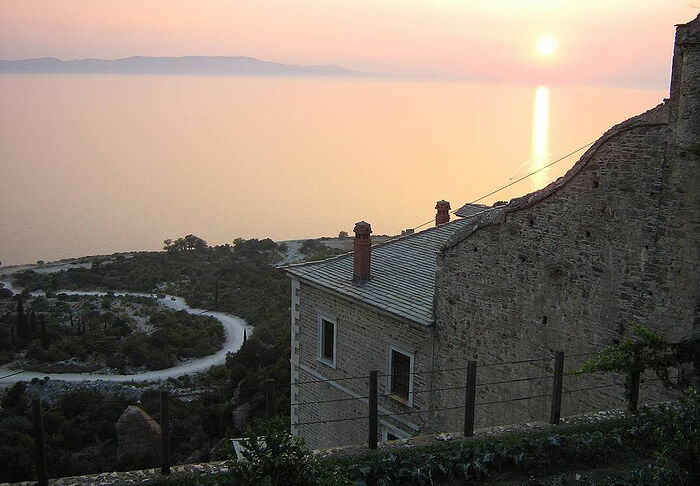 Athos. In the vicinity of the St. Paul’s monastery
Athos. In the vicinity of the St. Paul’s monastery
“I was walking along the road not far from here, in the woods,” he told me in amazement, “and then, I suddenly clearly saw, a little off in the distance and above the tallest bushes, the roof of a monastic cell. The roof was made of stone and it had a tiny dome typical of Mount Athos.”
He had walked here many times over the years and never saw any cells. He never saw it again in the future either. Not even once!
So, what was it? And who was it? Could it be the elders? So, here we go...
***
August 2007. During the whole month that I was on Mount Athos, I happened to live through several events of the same kind, and I immediately asked the local monks to interpret them for me. But their answers varied. Therefore, I leave it all to your own interpretation. For this purpose, I’ll try to depart from any literary character and simply recount the events literally, like an official record.
THE FIRST CASE
August 24th, Friday, around noon
Dormition fast. Commemoration of Venerable John of the Holy Mountain, the Hermit and Hiero-Schemamonk (1867).
I remember this morning quite well. I had just finished a visit to the beautiful Vatopedi Monastery—its two services, amazing shrines and the faces of the Athonite monks. By the way, there were many wearing black beards. Not gray, but black ones! Let’s take note, and I will come back to discuss the topic of young monasticism on the Holy Mountain one day.
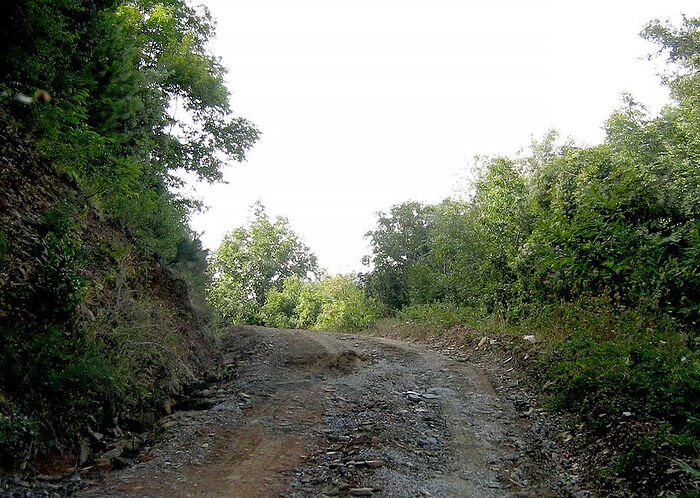 A place that looks similar to the one in Case One
A place that looks similar to the one in Case One
Since I had been to Zographou only yesterday, where I had heard a lot about the personality of Father Benedict, the former abbot of the monastery, I decided to pay him a “visit.” I knew where he lived (the Kaliva of Sts. Constantine and Helen), but no buses travelled to that forgotten corner. It made more sense to go there through the forest by foot, along the straight line. That’s what I decided to do.
The sun was already shining brightly, but the scorching midafternoon heat hadn’t started yet. Shouldering my huge backpack, I said a prayer and set out on my journey. After passing the monastery gardens and plantations, I went into the heart of the untrodden forest. I was guided by intuition, infrequent red signs and a very detailed map of Mount Athos I purchased ahead of time in Ouranoupolis store next to the bus stop. It even showed the walking paths assigned in Greek as “monopAti.”
My strict elder in Russia forbade me, a layman, to carry a prayer rope in public, but here, in absolute solitude, I was free from this restriction.
Oh my goodness! How intoxicatingly beautiful it was—to walk on the holy land of Athos, and in complete concentration, to pray the Jesus Prayer continuously using a prayer rope! When I grew tired of reciting it in Russian, I immediately switched to Greek. When I got tired of reciting it in Greek, I switched it back to Russian! My soul was exalted! Ultimate happiness would probably look like this…
***
I passed some large skete, I think, it was St. Demetrius. It was quiet and seemingly deserted. Unwilling to disturb the prayer hour of the monks, or maybe they were simply resting after the service, I tiptoed past the skete across the clearing and went deep into the thicket again.
Little by little, my walking path took me to a wide and completely deserted road. Well, it wasn’t a big road yet; it was in the process of being built. Lonely bulldozers and graders were left right there by the roadside. I don’t know where they were heading with it, but somewhere towards Konstamonitou Monastery. You could see that the hoes of this powerful machinery were used to cut the side slopes, turning this former path into a full-scale, perfectly leveled road.
In one place, I could see the ruins of a former monastic cell at the side of the ditch—its only surviving wooden upper parts were sticking dejectedly out of the sand.
I walked for a long while along this yellow sandy surface. That was the pass of the main ridge of the Holy Mountain. To tell the truth, its height here in the northern part of the peninsula is quite insignificant. The mountains here were rather looking like thickly wooded high hills.
Meanwhile, my road began to turn abruptly to the left, behind the corner. On the right, starting from the curb, it went sharply down as a steep mountain slope. On the left, a forested slope, cut vertically by a bulldozer bucket, hung over the road. In the distance, in the bright sunlight, I could already see the bay waters and the contours of the second “finger” of the Halkidiki peninsula.
I suddenly stopped short: I could sense someone invisible standing on my left, between me and the wall of the slope—someone I couldn’t see!
Holding a prayer rope in my hands, I calmly walked towards the turn, reading aloud the Jesus Prayer. But suddenly I stopped short: someone invisible stood on my left, between me and the wall of the slope! I heard only birds singing, but I had the feeling that the very hot censer of a priest was invisibly moving towards my face! Once... twice... Maybe even three times... I even instinctively thought of moving back a little; it seemed that another second and the censer would hit me on the nose!
To be sure, I didn’t hear the sound of its chains, but:
1. I smelled the overwhelming fragrance of the incense! I was simply overcome by its presence. Everything around me was so fragrant! It smelled truly fragrant!
2. I was almost burned by the heat of burning coal!
3. I clearly remembered the characteristic smell of burning coal in the censer!
To say that I was dumbstruck is to say nothing. Of course, I looked around, but no one was there.
***
Once I came back to my senses, I continued on my way. After a while, I heard the sound of an engine behind me—a yellow Land Cruiser was quickly catching up with me. The Toyota stopped, and I was greeted with a friendly wave of the hand: “Get in,” they said, “why are you standing there?”
Hieromonk Lavrentiy, the SUV driver, was from the Moldavian skete of St. John the Theologian in the very south of the peninsula, in the village of Provata. It is at the northern foot of the Holy Mountain. The skete has a “business assignment”—to drive wealthy Orthodox “tourists” around Mount Athos. But now, for some reason, he was alone.
His Russian with a soft Moldovan accent, heard here, so far from home, pleasantly delighted the ear. Batiushka kindly drove me all the way to the monastery of Karakallou, while I kept asking him what he, a priest, living on Mount Athos for a long time, was thinking about this overwhelming event.
“You know, Sergiy,” he answered, “when a skete produces its own incense, the production waste is usually thrown somewhere far away. You could have walked by such an ancient waste dump.”
Well, okay. That’s fine. If it’s production waste—let it be so. I took that into consideration and calmed down a little bit. So many things can happen on Athos! At least now I knew exactly what smells surround the righteous in the Kingdom of Heaven!
To be continued…

